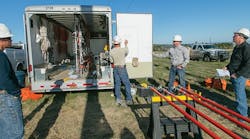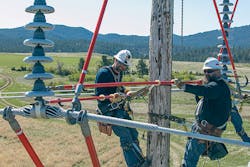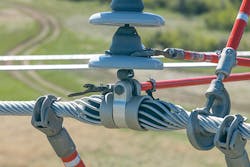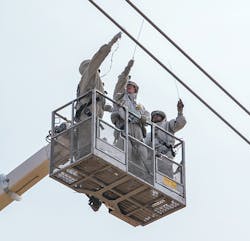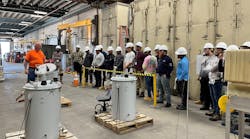Nearly 40 years ago, linemen for Basin Electric Power Cooperative began working on energized lines. Today, this live-line work method has become even more critical because of the challenge of taking power outages on a 345-kV line.
If the linemen want to work on a de-energized line, they may have to wait up to three weeks to get the outage cleared. In addition, during the time that the line is out-of-service, power plants need to curtail generation. As a result, the linemen prefer to use live-line techniques from barehanding to hot sticking whenever possible on maintenance and repair projects.
Rather than having a small, dedicated live-line crew, Basin Electric Cooperative has trained all 27 of its journeymen linemen to perform live-line, barehand and hot stick work on the cooperative’s transmission system.
Training Crews
During the majority of the year, the linemen work in seven different locations across four states including North Dakota, South Dakota, Wyoming and Nebraska. In the fall and in the spring, however, they meet in a central location for a one-week hotline school, which promotes camaraderie and teamwork.
In the spring, the field workforce — which also includes three mechanic operators — learn how to work on lower voltages and one-pole structures in Spearfish, South Dakota. Then in the fall, the school is focused on working live at higher voltages on lattice steel towers. To give the workers different lines to work and train on, the cooperative offers its fall training outside the Antelope Valley Station power plant in Beulah, North Dakota.
For the first part of the hotline school, the instructors train the linemen and mechanic operators on bucket rescue, hurtman rescue, conductor-cart rescue and self-rescue. As part of this training, they also teach the workers about the safety tools available with three different bucket trucks including the backup motor system, hydraulic let-down system and hydraulic bleed-down system. Then for the rest of the week, the instructors move on to hot stick procedures.
Because the cooperative does not have a dedicated training center, the training occurs out in the field. The superintendent, two assistant superintendents and lead linemen instruct the crews as they work live on Basin Electric Power Cooperative’s own system.
Performing Live-Line Work
Before working live on the system, the linemen must set up a hotline order with the system dispatch. This puts the line in one shot, which means that if anything happens, the line won’t become re-energized. That way, if a line trips or a hot stick flashes over, the linemen will be protected.
Next, the linemen set up the work site, review the tasks and ensure they have the right tools to perform the work. In addition, the crews inspect each one of the towers closely to mitigate any problems. They also ensure that all of the crew members know what position they will be in and what their job duties will be during the live-line work.
The crews then test all their tools electrically with a portable hot stick tester from A.B. Chance. After visually inspecting the hot sticks for cracks and damage, they run a tester over them to discover whether or not the sticks are sound. If they get high readings, it often means that the stick has a high level of moisture or contamination, which requires extra cleaning or removal from service.
At Basin Electric Power Cooperative, the linemen treat their hot sticks like delicate surgical instruments by keeping them extremely clean. To ensure that they stay in workable condition, the crews do not store their hot sticks inside their bucket trucks. Instead, they secure them on racks within a specialized walk-in hot stick trailer. Within this trailer, linemen can find ropes, hot sticks, yoke plates and any accessories needed to do live-line work.
Maintaining Lines
Following the hotline schools, the linemen use the live-line techniques to conduct repair and maintenance on the power lines using live-line methods. For example, the crews replace broken dampers or spacers on bundled lines. In addition, they often repair insulators that have been damaged by bullets during the hunting season.
The linemen select which live-line technique to use depending upon the specific job they are working on. Some of the tasks can be as simple to changing out a string of insulators or a crossarm to a major maintenance project.
Basin Electric Power Cooperative runs nine three-man crews. While the linemen are spread out across the service territory, they are still localized enough to pull in extra support for hot stick procedures. Every two weeks, the linemen perform some kind of live-line work.
In some cases, the linemen will also work on more extensive projects, such as a dead-end insulator replacement. On this job, seven linemen have to do a lot of rigging and hot sticking. By working out of bucket trucks, the linemen were able to save time on the procedures and have more versatility. In addition, the linemen also perform a lot of work using ropes, which is becoming increasingly common in the line trade.
Staying Safe
To protect the workforce while working live, Basin Electric Power Cooperative has invested in flame-retardant (FR) clothing and Faraday suits for each journeyman lineman. At all times, the linemen must wear FR clothing whether or not they are working live.
Every year, the cooperative gives the linemen an allowance for FR clothing from a local vendor, iGEAR. The first year of employment, the linemen receive a higher amount to cover the cost of winter gear and overalls. Then for the following years, the linemen can order jeans, shirts, coats and sweatshirts.
Each lineman is responsible for maintaining his or her own FR garments, and if they show any signs of wear and tear, they are retired and replaced with new apparel.
In addition to FR clothing, the linemen also use 100% fall protection including FR-rated line belts and harnesses from Buckingham Manufacturing and double pelican hooks on the lattice steel towers. When working on the lattice towers, the linemen have many places to stand and work on. On the wood poles, however, they need to work on their climbers, but the live-line tools are not as large and heavy.
Regardless of the type of structures the linemen work on, they ensure that they are carefully following the rules and procedures of live-line work. Over time, however, the crews have tried new work methods; if they prove to be successful, safe and save time, they are then incorporated into the cooperative’s procedures.
By working live, the linemen are able to boost productivity and circumvent the need to take an outage on a line. This improves the power reliability and keeps the power on for their customers year-round.
Vince Smith is the transmission line superintendent for Basin Electric Power Cooperative. He has worked for the company for 17 years, and he is responsible for overseeing the crews and their daily activities and scheduling training. He has worked in the field for 29 years and is a journeyman lineman.
Editor’s note: View a video of the live-line training at http://bcove.me/myujome0.
